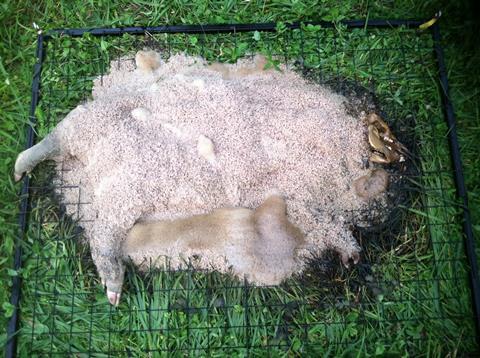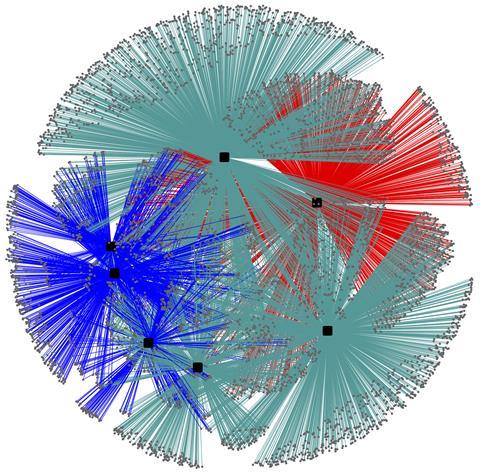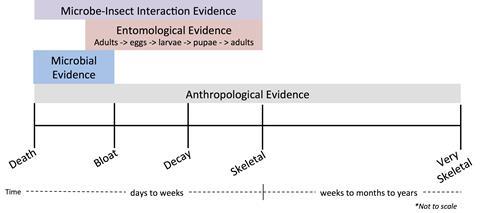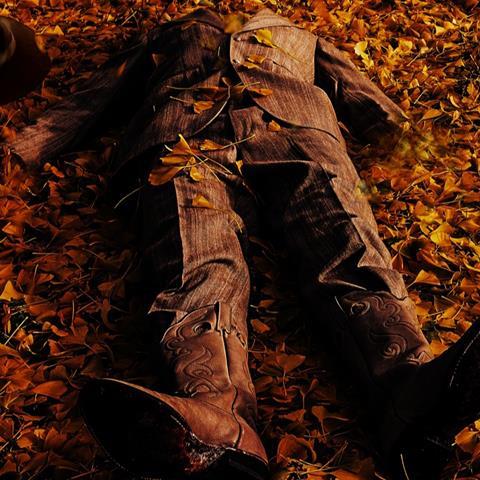Do you work in forensic microbiology, or have an interest in it? Click here to find out about our upcoming AMI event on the topic!
Over the last several years there has been increasing recognition of the importance of establishing a strong basic science foundation in forensics. With the development, reliability and increasingly widespread use of high-throughput sequencing technologies, the forensic sciences are poised to harness ‘-omics’ technology to bridge basic science with medicolegal applications and applied microbiology.
Many studies have demonstrated the ability to detect and identify host-associated microbial communities of living humans, those of non-living humans (e.g. cadavers) and environmental microbial communities in forensics (e.g. as trace evidence or time of death estimates). These communities have been described as post-mortem microbial communities, the post-mortem microbiome the carrion microbiome, along with several other terms and descriptions. However, for this article, we use the human post-mortem microbiome (HPMM) to describe this community and argue that the characterisation and assessment of intra-individual variation of the HPMM shows considerable promise for applications in the forensic sciences.
”The necrobiome is composed of the community of organisms associated with decomposing animals that includes members of all three domains of life (Bacteria, Archaea, and Eukarya)”
An increased understanding of the HPMM and microbiomes of other organisms or substrates associated with cadavers (e.g. insects and the soil beneath) has led to the identification of novel biological markers potentially useful in forensics. Trace evidence is typically physical items, such as fibres, hair or pollen, that link a perpetrator to a victim or crime. However, as genomic technology and computation power has rapidly advanced so has the efficiency to analyse large data sets (e.g. high-throughput sequencing); thus, scientists and practitioners are positioned to explore alternative and underexplored research avenues linking widely distributed microorganisms (e.g. bacteria, fungi, protists, and algae) to human cadavers or other objects or substrates at a death scene investigation. The last decade has seen a tremendous increase in our understanding of the ecological factors that affect these linkages and scientists are developing ways to use microbiomes in questions of provenance.

Mapping the Necrobiome
To better appreciate the biotic interactions of microbial taxa during vertebrate carrion decomposition, it is necessary to place this community within the larger network of cadaver-associated organisms (e.g. invertebrates and vertebrate scavengers) – the network of species that has been defined as the necrobiome. The necrobiome is composed of the community of organisms associated with decomposing animals that includes members of all three domains of life (Bacteria, Archaea, and Eukarya). The primary eukaryotes of the necrobiome are considered the insects, particularly blow flies (Diptera: Calliphoridae); these flies thrive in decomposing vertebrate remains, organic materials (e.g. garbage), and vertebrate wastes (e.g. manure). Blow fly adults are primary colonisers of decomposing vertebrate remains, and are commonly the first forensically important insect taxa to arrive at human remains in response to odours given off by the metabolism of microbial communities associated with the carcass. The microbial members of the necrobiome are considered the internal and external (epinecrotic), endogenous communities, along with those exogenous taxa that arrive from external sources such as adult blow flies. These microorganisms are associated with carrion, including human cadavers, throughout the decomposition process, and research into these communities has greatly expanded in recent years.
As an example of this research can be seen in the image below. Scientists in the Department of Entomology at Michigan State University identified certain microbial taxa of the internal microbiome of two cohorts of adult blow flies collected at two time points (blue = initial day; green = 10 days later) that shared taxa similar to those of epinecrotic communities of decomposing carcasses (salmon carcass; red). These microbiome associations are visualised in a co-occurrence network. The nodes (black boxes) represent the individual samples from the blow flies or the carcass with the edges (coloured lines) connecting to the identified operational taxonomic units (OTUs; grey circles) that represent individual bacteria taxa. The variability of microbial communities is apparent amongst each node but there are community similarities based on adult cohort and the carrion resource. Thus, there is evidence that the microbiome of blow flies and that of the carcass (or corpse) interact during the decomposition process.

Understanding and modelling how interactions amongst microbial communities occurs during decomposition is proving to be important for developing hypothesis-driven questions that are now being applied in research for forensic application. One of the more provocative and applicable questions related to post-mortem microbial communities is: How do these complex assemblages of microorganisms interact with primary consumers, such as the necrophagous insects commonly used in forensic investigations, of a carcass or human corpse?
Microbial Community Interactions
The interactions between microbes and necrophagous insects can begin within hours after death when the first insects are attracted to, evaluate and consider colonising a cadaver (Figure 3); this period of decomposition with extensive interactions is also where both insect and microbial evidence can be easily collected. Furthermore, microbial communities are hypothesised to alter the quality of the resource and thus mediate insect community colonisation. Support for this hypothesis has been demonstrated here and here, in studies where the production of metabolically-derived volatile organic compound signatures from microbes influenced necrophagous fly behaviour. A better understanding of mechanisms controlling community assembly patterns that influence carrion/corpse necrobiome diversity and interactions is key since decomposition is a consumer driven process, and changes in the organisms utilising the remains ultimately dictates decomposition rates. These mechanisms can influence how microbial and entomological evidence could be used in legal investigations. One common way that biological evidence is used in forensics is to estimate the minimum range of time between death and the discovery of human or animal remains, or the minimum post-mortem interval (PMImin).

Estimating a PMImin range with strong statistical inference continues to be a challenge for forensic scientists. In 2009, the US National Research Council (NRC) called for a need to provide quantitative error rates in inferences derived from most forensic evidence. Many studies concerning community assembly for either the insect or microbial taxa do not employ validations to define error rates. Consequently, regardless of their admittance into a court of law, these techniques fail to meet the Daubert guidelines which govern the admissibility of evidence into the courtroom in the USA, or the defined parameters outlined by the NRC. However, in recent years there has been a substantial research effort to better estimate error rates in all biological evidence. There is still a need for increased hypothesis driven forensic microbiological studies that can facilitate defining and refining error rates related to PMImin estimates, and other ways that microbes can be potentially used in forensics. However, as it has been shown in other emerging disciplines, a strong foundation in the basic biology and ecology of a system is necessary for identifying applications for improving the human condition. The necrobiome and interactions of microbes and insects on decomposing humans is no exception within the broader field of microbiolog








No comments yet